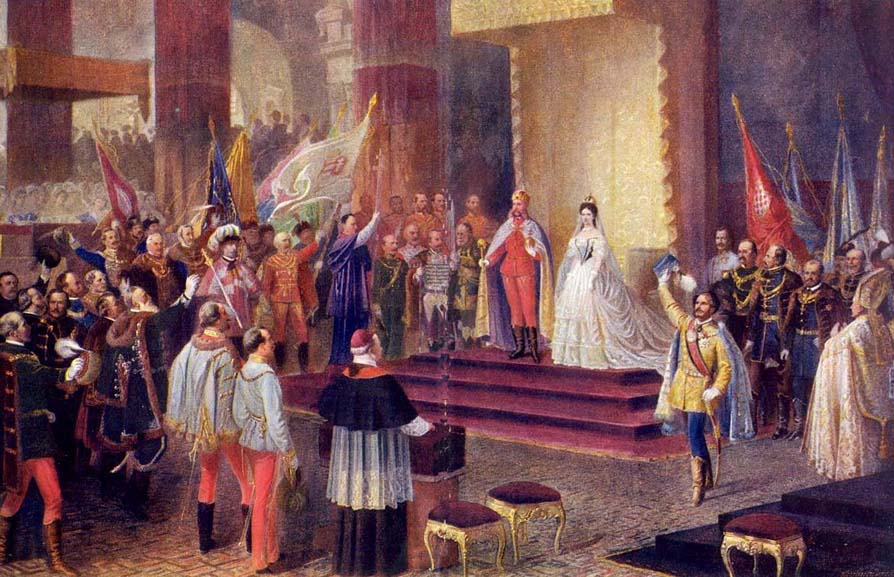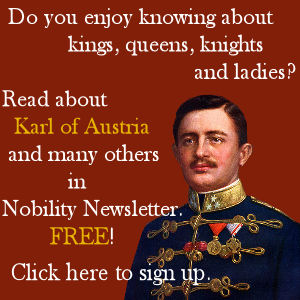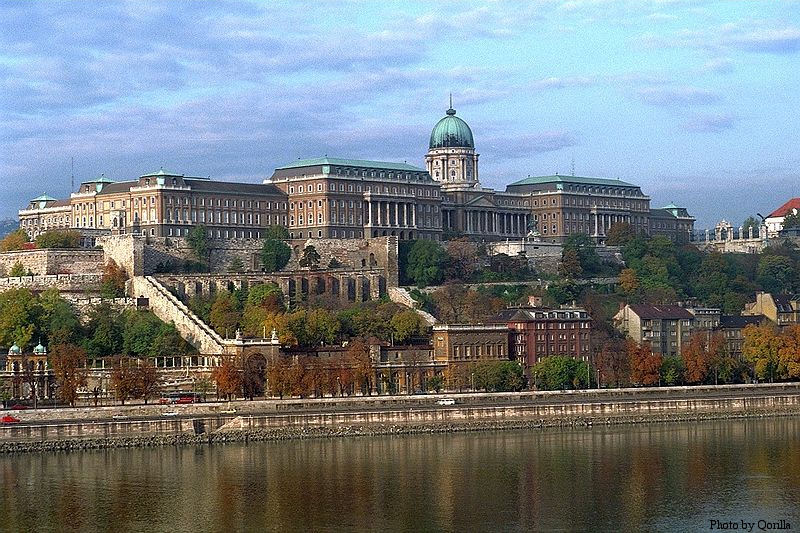The royal castle of Buda is a marvel of antique architecture. It was built in 1769, and ever since 1771 the hand of St. Stephen has been preserved as a sacred relic within its ponderous walls. Every year, on the 20th of August, a procession leaves the citadel, the relic being carried from there to the Church of Our Lady of the Assumption, and back again, to the sound of thrilling music, and under a veritable hail of blossoms.

Coronation of Emperor Franz Joseph and Empress Elisabeth of Austria as King and Queen of Hungary, on June 8th, 1867, in Buda, Capital of Hungary. Work of Ödön (Edmund) Tull.
On the coronation day, all those who had been invited by the government or the municipal authorities occupied seats on the official grandstands. When their majesties issued from the palace on their way to the cathedral deafening “eljens” were raised, and were kept up almost uninterruptedly. The Emperor and Empress rode in a magnificent state carriage drawn by eight white horses. At the moment that the procession began to move, a salute of one hundred and one minute-guns was fired from the citadel. The procession was headed by mounted police, followed by the carriage of the governor of the city and by that of the chief of police, and was the most brilliant pageant imaginable.
The escort of one hundred and eighty-two aristocrats was an especially magnificent sight. Twelve pairs of cavaliers, whose horses were led by armor bearers in Magyar dresses, were followed by eight mounted magnates, each of whom carried a banner. The others all came in pairs, each horse being led by one or two armor bearers. All the nobles wore the splendid dress of the Hungarian magnate, adorned with gold embroidery and precious stones from the kalpak—or head covering, which is surmounted with herons’ feathers—down to the high boots. The reins, gilt stirrups, and the shabracks and golden scabbards of the scimitars were covered with diamonds and jewels, many of them being worth a fortune. The imperial carriage was accompanied by the adjutant-general and by the Hungarian minister.
 The procession was followed by six carriages containing court officials, and by several hundreds of the carriages belonging to members of the episcopacy and the aristocracy. Most of the coaches and harnesses were covered with gems and gold. The long train went at a foot pace through the gloriously decorated streets, amid the cheers of several hundred thousands of spectators. The English know how to cheer, but their “hurrahs” are not to be compared for volume of sound with the thundering shouts heard on that day. Maidens dressed in white showered flowers on the road followed by the procession, invoking blessings on the heads of their handsome sovereign and his lovely consort.
The procession was followed by six carriages containing court officials, and by several hundreds of the carriages belonging to members of the episcopacy and the aristocracy. Most of the coaches and harnesses were covered with gems and gold. The long train went at a foot pace through the gloriously decorated streets, amid the cheers of several hundred thousands of spectators. The English know how to cheer, but their “hurrahs” are not to be compared for volume of sound with the thundering shouts heard on that day. Maidens dressed in white showered flowers on the road followed by the procession, invoking blessings on the heads of their handsome sovereign and his lovely consort.
So great was the enthusiasm aroused by the appearance of the Empress-Queen, that it is scarcely wonderful if her whole heart went out anew to a people who, by the warmth of their reception, the many tokens of admiration and love bestowed upon her, presented so vivid a contrast to the manner in which the Teutonic portion of her husband’s subjects had comported themselves towards her when the imperial crown had been placed upon her brow, almost thirteen years before. Her predilection for Hungary from henceforth became more than ever marked. She learned the terribly difficult Magyar language with her usual facility, devoting herself with such energy to this task that she absolutely amazed her instructors, and most of her time was spent in her marvelous Castle of Gödöllö, near Budapest.
Marguerite Cunliffe-Owen, The Martyrdom of an Empress (New York: Harper & Brothers, Publishers, 1902), pp. 63-65.
Short Stories on Honor, Chivalry, and the World of Nobility—no. 205











